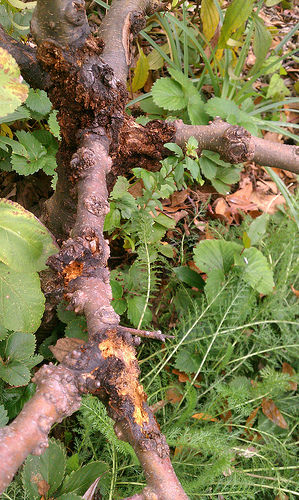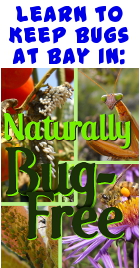
Low-work fruit tree pest and disease treatment
 As I mentioned in my last post, Gene Logsdon's philosophy on dealing with pests and diseases is much less hard-core than Michael Phillips'
since the former is only growing food for his own table. In
general, Logsdon believes that as long as you can keep your fruit trees
alive, all other problems are cosmetic and can be treated or not as you
choose.
As I mentioned in my last post, Gene Logsdon's philosophy on dealing with pests and diseases is much less hard-core than Michael Phillips'
since the former is only growing food for his own table. In
general, Logsdon believes that as long as you can keep your fruit trees
alive, all other problems are cosmetic and can be treated or not as you
choose.
So how does
Logsdon deal with pests and diseases? He begins his
trouble-shooting by choosing resistant varieties (which I listed
previously), then moves on to low-key preventatives. For
fire-blight prevention, he recommends keeping nitrogen levels low,
perhaps feeding your trees only with a mulch of leaves,
cardboard, old hay, straw, manure, tobacco stems, grass clippings, or
clover. Meanwhile, he minds phosphorus levels as well since too
much of this nutrient will suppress mycorrhizal fungi, which are
particularly essential for healthy peaches. Finally, Logsdon
strives to keep problematic fungi in check by ventilating with summer
breezes.
One of our readers
sent me an email (with the photo above) a couple of weeks ago
mentioning how a woodpecker came by to deal with the borers that moved
into his apple burr knots, and that turns out to be Logsdon's solution
for codling moth larvae as well. One study showed that if you
allow natural woodland to grow up adjacent to your orchard, woodpeckers
can eat up to 52% of overwintering codling moth larvae. Meanwhile,
brush piles attract other beneficial birds, wild places attract
predatory insects, and even the lightning bug larvae living in unsprayed
lawns will eat slugs and snails. Maybe that's why Mark and I have
fewer non-fungal issues than I would expect --- because our core
homestead is surrounded by acres of natural forest?
 This post is part of our Organic Orcharding lunchtime series.
Read all of the entries: This post is part of our Organic Orcharding lunchtime series.
Read all of the entries: |
Want more in-depth information? Browse through our books.
Or explore more posts by date or by subject.
About us: Anna Hess and Mark Hamilton spent over a decade living self-sufficiently in the mountains of Virginia before moving north to start over from scratch in the foothills of Ohio. They've experimented with permaculture, no-till gardening, trailersteading, home-based microbusinesses and much more, writing about their adventures in both blogs and books.
Want to be notified when new comments are posted on this page? Click on the RSS button after you add a comment to subscribe to the comment feed, or simply check the box beside "email replies to me" while writing your comment.
